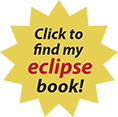10 Ways NOT to Observe the Eclipse
With the August 21, 2017, total solar eclipse now less than 1,000 days away (and, depending when you’re reading this, possibly a lot less), people are beginning to discuss safety issues related to observing the Sun. In my opinion, a lot of them are going overboard.
“Don’t look at the Sun!” “The Sun is dangerous!” “Never look at the Sun!” “The Sun will blind you!” Listen, if these pronouncements are all we hear for the next two and a half years, even I might stay indoors during the eclipse!!!
We all want everyone to view the event, and we want them to do it safely. But rather than just screaming “Don’t!” and “Never!” how about if we phrase this a bit more positively: “The best way to view …” or “One safe way to view …”?
That said, some definite no-no’s come to mind regarding solar observing, and as the eclipse gets closer, we’ll need to spread the word as to what’s right and what’s wrong. So, I’ve created a list of 10 ways you never should observe the Sun.
1. Space blankets or telescope covers
Some people see approved “Sun-viewing glasses” made of cardboard and a thin sheet of Mylar, and they immediately believe any similar material will serve as a safe solar filter. Not true. The material manufacturers use in the glasses is optical Mylar, a special type that filters most of the visible light and all of the truly dangerous infrared and ultraviolet radiation. This material has been certified safe by laboratories and organizations of opticians and ophthalmologists. Space blankets and Mylar-infused telescope covers have totally different purposes and are not safe to view the Sun through.
2. Black-and-white film that uses dyes instead of silver
Some experienced solar observers have used older black-and-white film to safely observe the Sun. This process involves completely exposing the film to light, developing it to maximum density, and stacking (taping together) at least two layers of it. Some newer films, however, use dyes instead of the silver compounds found in the older types. That makes them unsafe to view the Sun through.
3. Medical X-rays or any film with an image on it
This one’s easy to explain. Think of the image on any negative or X-ray the same way you would think of a great big hole.
4. Compact discs
The silvering on compact disks, DVDs, or Blu-ray discs is not optical Mylar, and so it’s not safe to view through. And even if it were safe, the plastic between the silvered layers would distort the Sun’s image so badly that you’d immediately throw the disc away.
5. Smoked glass
Smoke is ash. It also will contain other chemicals depending on what you have burned. Ash is opaque. That is, it doesn’t let light through. So, if you use glass that you have smoked (probably with a candle flame), all you’re doing is cutting down the amount of light and other radiation reaching your eyes. As the light dims, you might think, “Hey, it’s safe to observe now.” Absolutely not true. The same principle works against our eyes as the total part of a solar eclipse approaches. As 95 percent – and more – of the Sun’s light disappears, people who don’t know better believe it’s safe to observe our daytime star. Also totally untrue. Please note that the other type of smoked glass (sometimes called frosted glass), the kind manufacturers make for effect, is also unsafe for solar viewing.
6. Sunglasses or multiple sunglasses
Just because the word “Sun” is part of this item, it doesn’t mean you can look directly at the Sun through them. And “UVA” or “UVB” protection means the material will block some of the harmful solar rays, but only indirect ones, that is, those reflected off earthly objects. Do not use sunglasses – or even multiple pairs stacked – to view the Sun.
7. Color film
Like some of the newer black-and-white films, color film only contains dyes. It never has any of the silver compounds, which remain within the emulsion after you develop black-and-white film, making it safe for solar viewing. Never look through color film at the Sun, no matter how dark it appears and no matter how many layers you stack.
8. Neutral density filters
Neutral density (ND) filters reduce the amount of all wavelengths of light striking them. They come in a variety of flavors: 60 percent, 40 percent, 10 percent, even 3 percent. The numbers indicate how much of the (100 percent of) light striking the filter passes through. But what’s the key word here? Yep: light. ND filters, which are great for cutting down the Moon’s light, do not impede infrared or ultraviolet radiation.
9. Polarizing filters
For the most part, amateur astronomers use this accessory as a variable neutral density filter. By changing the angle of transmittance of the two filters that make up a polarizer, they can select how much light comes through. So, instead of buying four ND filters, they buy one polarizer. Unfortunately, as with ND filters, polarizers do not block infrared or ultraviolet radiation, so don’t use one to look at the Sun.
10. Any “solar” filter that screws into or fits over an eyepiece
Through the years, this is the one item on this list that has had the potential to cause the most damage. Why? Because well into the 1980s, some manufacturers packaged them with their telescopes, thus putting an invisible seal of approval on them. Nobody includes them with telescopes these days. If you have one, throw it away immediately. The Sun’s light, concentrated on this type of filter by a telescope’s optics, has cracked many of them, sometimes with eye-damaging results.

